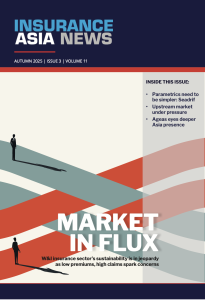Asia cyber pricing may bottom out, but London capacity adds pressure
January 7 2025 by Mithun Varkey
Cyber capacity from London is applying additional pressures on Asian market in terms of pricing, but the market is getting closer to bottoming out, according to Samuel Bye, head of cyber for Asia and the Middle East at Axa XL.
Pricing is primarily driven by a relatively large influx of new capacity providers, or increased appetite from insurers for cyber, Bye said.
“We’ve seen in the last 12 to 18 months quite a few new underwriting outfits, or insurers beefing up their underwriting teams,” he said.
“For the first time ever, capacity from outside Asia is looking to explore opportunities.
“London has traditionally been a market that hasn’t been interested in transacting in Asia, but in the last 12 to 18 months, we’ve seen an increase in interest.”
However, Bye is hopeful that the market would “find a threshold where [underwriters] don’t want to go much lower in terms of risk versus reward. And for capacity deployment, at some point we will find a kind of agreed market level”.

“Primary rates have also dropped, but they are going to hold more adequacy than the excess layers.”
Samuel Bye, Axa XL
“Last year, we saw roughly numbers between -10% to -30% rate change in the market. I don’t think we’re going to see those levels again. Every insurer has fixed costs built into their pricing,” he added.
Looking at combined operating ratios, insurers had a pretty good year last year, so people are looking to grow, and cyber seems to be the most organically growing product, Bye said.
“We’ve seen around 20% year-on-year growth,” he added.
Primary vs XL
To drive value in the market, Bye believes that firms must play in the primary or low excess market.
“Our preference and appetite is for that,” he said. “We want to be in primary because you get more reward for your risk.”
The influx of XL-only capacity has put even more pressure on XL pricing.
“We’ve seen increased limit factors drop by 10% to 20% compared to what we saw two to three years ago. There’s been a large drop in the excess-to-excess layer,” he said.
“Primary rates have also dropped, but they are going to hold more adequacy than the excess layers.
“I’d rather work closely with clients and actually add value as an insurance partner than just be a piece of paper they could use in the event of a claims payout.”
Claims catch up
Bye thinks that claims activity, though it seems relatively low, would eventually catch up.
The issue is that in 2020, when there were eight to 10 key cyber insuring markets, the losses were spread between fewer insurers.
Now, with 15 to 20 or more capacity providers, the losses are more widely distributed, so the market can sustain increased losses for a longer period.
“I think it will take maybe a few large market events to potentially change anything,” he said.
And it does not even have to be catastrophic events; an increase in what are called mini catastrophes, like Log4J, MOVEit, SolarWinds and CrowdStrike, still causes widespread problems for the insureds.
“The value clients see lies more in BI coverage at the moment, which remains a valuable tool for balance sheet protection even if they're not purchasing the additional services."
“Catastrophe modellers are looking at major systemic problems occurring. But what we're seeing is a creeping trend of smaller incidents that are not as large as a catastrophic event," Bye added.
“In the frequency and severity models, I think frequency is actually a little bit more relevant for modelling catastrophe events. There should be more modelling done of these mini catastrophes."
He cautioned about the increasing limit deployments in the regional cyber market.
The market, having earlier pulled back to about US$5 million limit, is now seeing many limits increased to US$10 million.
“I think limit management is one of the key tools to protect your portfolio,” he said.
“We try to manage that carefully, but that doesn't mean we're scared of using US$10 million if we need to; it just means we pick the right times and places to deploy that capacity.”
Market drivers
Increasing regulation across the region, with many countries now bringing in updated data privacy regulations, is helping grow the cyber insurance market.
However, the driver of losses and premium loading is typically first-party coverages, like cyber extortion, ransomware and business interruption (BI), he said.
“The laws are more stringent, fines may be more punitive in nature, but in terms of day-to-day operations, if there's a data breach, we're not seeing the fines, penalties, or general claim sizes as you would in markets like the US and Australia,” he said.
“The value clients see lies more in BI coverage at the moment, which remains a valuable tool for balance sheet protection even if they're not purchasing the additional services. The lower pricing makes it a very cost-effective tool to transfer that risk."
Bye remains positive about the growth prospects in the region.
“Asia, compared to many other markets, has a really high propensity for growth. We have many large corporations that are not buying yet. So the opportunity for growth is actually really exciting,” he said.
While the Singapore and Hong Kong markets are relatively mature in the sense that the majority of large entities and corporations are buying cyber coverage, the major growth areas for Axa XL’s cyber offerings are typically Malaysia, Thailand, Indonesia, Vietnam and the Philippines.
Bye said the insurer was looking at solutions to cater to the SME segment in the region, or companies that have less than US$250 million in revenue, which have been underserved.
“It's a marketplace that I'm definitely going to focus on this year. We're going to start building out solutions around that," he added.
Bundling cyber with other products is another solution they are exploring.
“I think it's not a bad thing to be able to bundle products, as long as you know internally you can allocate that and make it work well for you. I'm not personally against it,” he added.
Local capabilities
Bye stated that the key to growth for Axa XL in the region was to transform from a payer to a partner.
Axa XL, which is fully established in post-breach services with breach coaches and vendors across the region, is starting to build out pre-breach services.
Localisation for the region is key, Bye said. It helps clients stick with local capacity because they prefer underwriters who “have deep knowledge of the legal and regulatory landscape across Asia”.
“We've got new wordings coming, and part of that will be getting them localised and ready for all countries in which we trade. Nobody wants a product that's not really built for what their market is offering,” he added.
“A foreign insurer may not be nuanced in terms of the different requirements per country. They may not have the vendor relationships in those countries to service claims properly.
“Even if we may be slightly more expensive, the value you actually get from the policy and the knowledge that we bring with it just adds up. Clients are more than happy to pay for that, knowing they're going to get a lot more benefit from it."
-
QBE | Elevating customer experience, humanising claims: QBE Asia’s ‘Solutions in a Box’
Vastly improving turnaround times and personalising service delivery, QBE Asia’s award-winning, end-to-end bundled claims solutions is a game-changer for the insurance industry.
-
Beazley | What does cyber protection look like from day 1 to day 600 and beyond?
Cybersecurity is no longer just an IT concern, but a governance issue that belongs on the boardroom agenda.
-
Sedgwick | Preparing for the next storm
Insurance industry needs to recalibrate, invest in innovation and strengthen systems, talent and data practices.
-
Peak Re | From climate modelling to market opportunity: Forging a new clarity on Southeast Asia’s climate risk
Southeast Asia's protection gap: a crisis of clarity, not just capital

